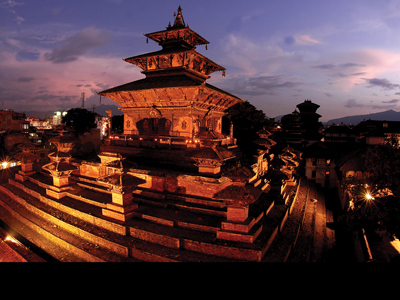Taleju became the guardian deity of the Malla kings and Taleju temples were built in her honor in all the three cities.
In this enchanting valley lie many mysteries, full of epic tales and endearing anecdotes. Every direction we turn to is a symbolic representation of religion and culture. As the festival of Dashain draws closer, and the belated monsoon continues to rinse us, more stories are unraveled.
 This valley is enshrined with three Taleju temples, each located in a different medieval palace; in Kathmandu, Patan and Bhaktapur. Though linked by a common belief, they all have their own stories to tell. Taleju, the divine mother Goddess (one of the many forms of Durga) has been the patron deity of Nepal’s royal families for centuries. The Kathmandu Taleju temple is a three-tiered pagoda and stands by itself at the edge of the Hanuman Dhoka Durbar
This valley is enshrined with three Taleju temples, each located in a different medieval palace; in Kathmandu, Patan and Bhaktapur. Though linked by a common belief, they all have their own stories to tell. Taleju, the divine mother Goddess (one of the many forms of Durga) has been the patron deity of Nepal’s royal families for centuries. The Kathmandu Taleju temple is a three-tiered pagoda and stands by itself at the edge of the Hanuman Dhoka Durbar
Square. Its superb architectural beauty can be appreciated from Makhan tole. The Taleju temples in the other two cities are integral parts of the palace. In Patan, the temple rises high above the palace complex, and is also a three-tiered pagoda. Its beautiful struts and wind-bells can be admired from the Durbar Square. In Bhaktapur, the Taleju temple is low and only two storied, but elaborately decorated, and well hidden from the square. Of the three, only the Bhaktapur Taleju allows the general public access on a daily basis. The Taleju in Kathmandu is open to the public only once every year, while the Taleju in Patan is strictly out of bounds for the common people; just the temple priest may enter the latter for prayers everyday.
The ninth day of Dashain is called ‘Nawami’ and the Taleju temple at Hanuman Dhoka, Kathmandu is opened to the public on this day. Thousands of devotees queue up to enter the complex and pay their respects to the Goddess. During this festival, a large number of animals are sacrificed in the vicinity of the Taleju temples.
All Talejus have their own unique significance, but the Taleju Bhawani in Bhaktapur remains the most mysterious and intriguing. It is a sanctuary for all kinds of tantric rites and incorporates very complicated and varied beliefs and rituals. Goddess Taleju is supposed to have transferred her powers to the nine (Nava) Durgas who are said to use these powers to protect the city of Bhaktapur for nine months. A festival that continues for nine days represents the nine-month period. Although all nine days are fascinating, the seventh day stands out as it enforces the presence of the Goddess Taleju once again. An image of Goddess Taleju is concealed in a cloth and is brought down from a room on the second floor of the temple. It is then carried in a procession led by the chief Taleju priest accompanied by musicians and sword bearers. Concealing the image induces a mystery, whether it represents the ‘true image’ of the goddess or not, and mystifies the spectators eagerly watching the midnight procession.
An interesting aspect of the Bhaktapur Taleju is the ‘white horse’ that is kept in the temple premises. In the entire year, this horse has a sacred duty to perform on only one day; on the night of Dashami (tenth day), during the Dashain festival, it is taken out on a procession carrying the idol representing the Goddess Taleju. According to the soldiers guarding the temple, this horse on its own, opens and closes the door, when it moves in and out of the stable.
Festivals and legends in Nepal intermingle in harmony and there is no line of separation between one and the other. Somewhere amidst the stories, processions and festivals, they all connect, thus intriguing, fascinating and bewildering us.









